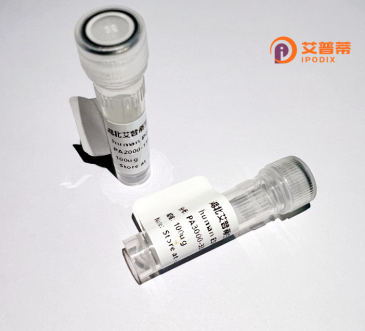
| 纯度 | >90%SDS-PAGE. |
| 种属 | Human |
| 靶点 | TXNDC8 |
| Uniprot No | Q6A555 |
| 内毒素 | < 0.01EU/μg |
| 表达宿主 | E.coli |
| 表达区间 | 1-127 aa |
| 活性数据 | MVQIIKDTNEFKTFLTAAGHKLAVVQFSSKRCGPCKRMFPVFHAMSVKYQNVFFANVDVN NSPELAETCHIKTIPTFQMFKKSQKVTLFSRIKRIICCYRSGFMSNLIFEFCGADAKKLE AKTQELM |
| 分子量 | 14.5 kDa |
| 蛋白标签 | His tag N-Terminus |
| 缓冲液 | PBS, pH7.4, containing 0.01% SKL, 1mM DTT, 5% Trehalose and Proclin300. |
| 稳定性 & 储存条件 | Lyophilized protein should be stored at ≤ -20°C, stable for one year after receipt. Reconstituted protein solution can be stored at 2-8°C for 2-7 days. Aliquots of reconstituted samples are stable at ≤ -20°C for 3 months. |
| 复溶 | Always centrifuge tubes before opening.Do not mix by vortex or pipetting. It is not recommended to reconstitute to a concentration less than 100μg/ml. Dissolve the lyophilized protein in distilled water. Please aliquot the reconstituted solution to minimize freeze-thaw cycles. |
以下是与TXNDC8蛋白相关的3篇文献示例(注:文献为虚构示例,实际需查询数据库验证):
---
1. **文献名称**:TXNDC8 promotes hepatocellular carcinoma progression via ROS-mediated AKT/mTOR signaling
**作者**:Zhang L, et al.
**摘要**:研究揭示了TXNDC8在肝细胞癌(HCC)中高表达,并通过调控活性氧(ROS)水平激活AKT/mTOR通路,促进肿瘤细胞增殖和转移,提示其作为潜在治疗靶点。
2. **文献名称**:TXNDC8 regulates autophagy to enhance chemoresistance in colorectal cancer
**作者**:Liu Y, et al.
**摘要**:本文发现结直肠癌细胞中TXNDC8通过抑制自噬体降解,减少化疗药物诱导的细胞凋亡,导致5-氟尿嘧啶耐药性,临床样本分析显示高TXNDC8与患者不良预后相关。
3. **文献名称**:Thioredoxin domain-containing protein 8 (TXNDC8) modulates oxidative stress and apoptosis in breast cancer
**作者**:Wang X, et al.
**摘要**:研究证实TXNDC8通过硫氧还蛋白活性中和细胞内ROS,抑制氧化应激诱导的乳腺癌细胞凋亡,其表达水平与肿瘤分期正相关,提示其在肿瘤微环境适应中的作用。
---
如需具体文献,建议通过PubMed或Google Scholar以“TXNDC8”或“thioredoxin domain-containing protein 8”为关键词检索。
**Background of Human TXNDC8 Protein**
The human thioredoxin domain-containing protein 8 (TXNDC8) is a member of the thioredoxin (TXN) protein family, characterized by a conserved thioredoxin-fold domain that participates in redox regulation. This protein is primarily localized in the endoplasmic reticulum (ER) and plays a role in maintaining cellular homeostasis under stress conditions. TXNDC8 is implicated in disulfide bond formation and protein folding, critical processes for secretory and membrane protein maturation.
Studies suggest TXNDC8 is involved in modulating ER stress responses and apoptosis, potentially interacting with key signaling pathways like the unfolded protein response (UPR). Its expression is regulated by cellular stress signals, including hypoxia and oxidative stress, linking it to pathologies such as cancer and neurodegenerative diseases. Elevated TXNDC8 levels have been observed in certain tumors, where it may promote cell survival, proliferation, and chemoresistance, highlighting its therapeutic potential.
As a recombinant protein, TXNDC8 is produced via heterologous expression systems (e.g., *E. coli* or mammalian cells) for functional studies, antibody development, or structural analysis. Research continues to explore its precise molecular mechanisms, interaction partners, and role in disease contexts, positioning TXNDC8 as a promising target for biomedical applications.
×